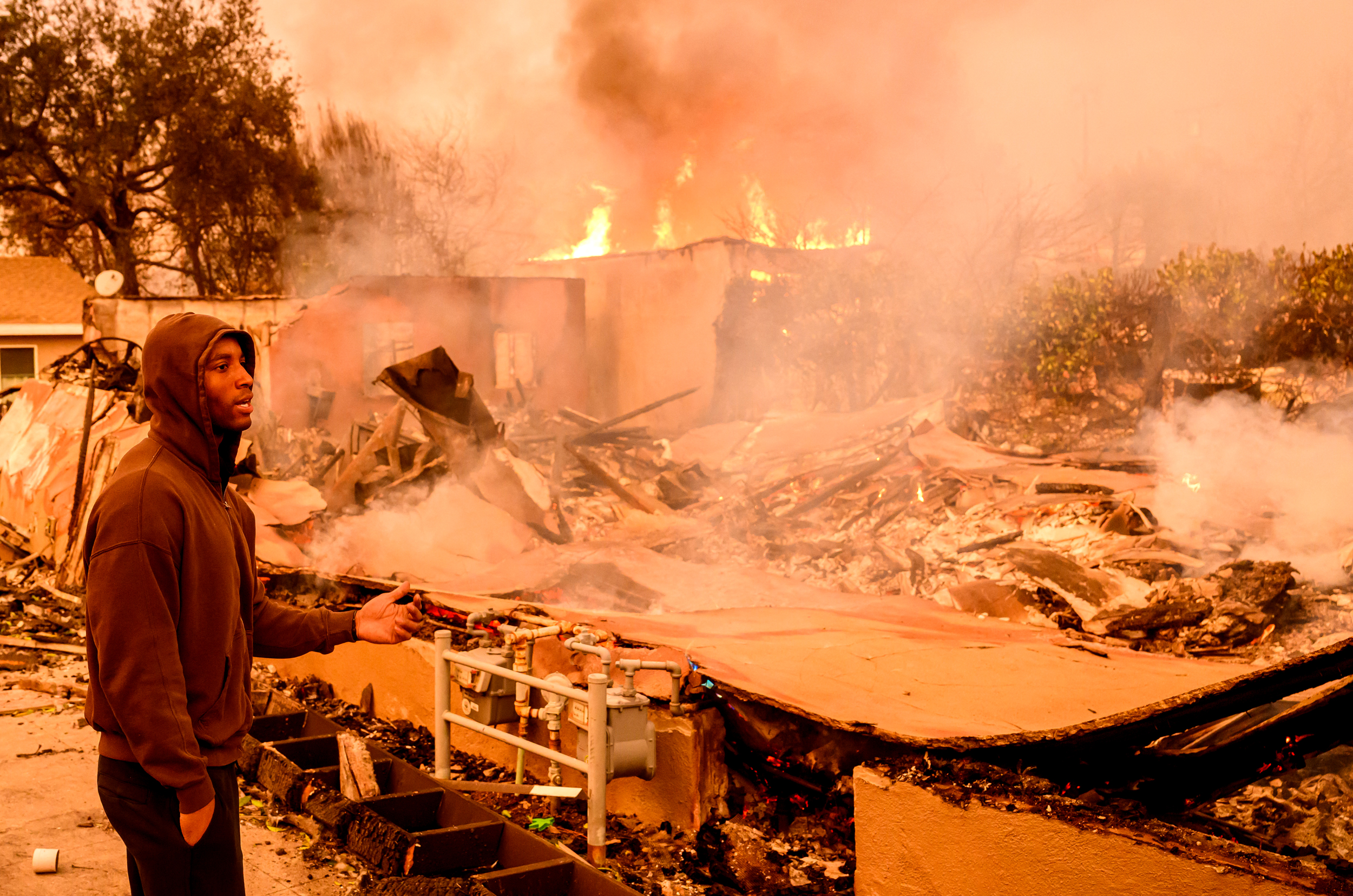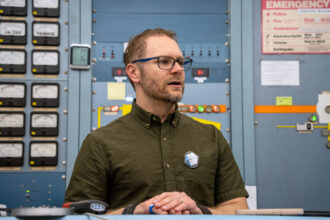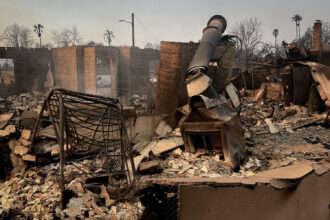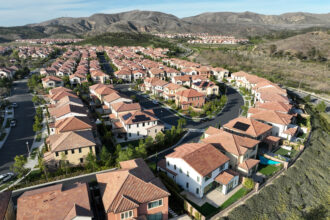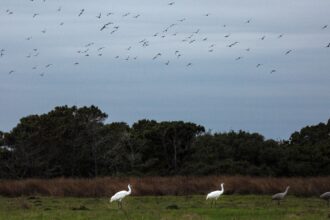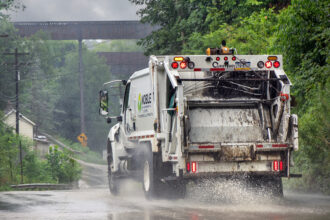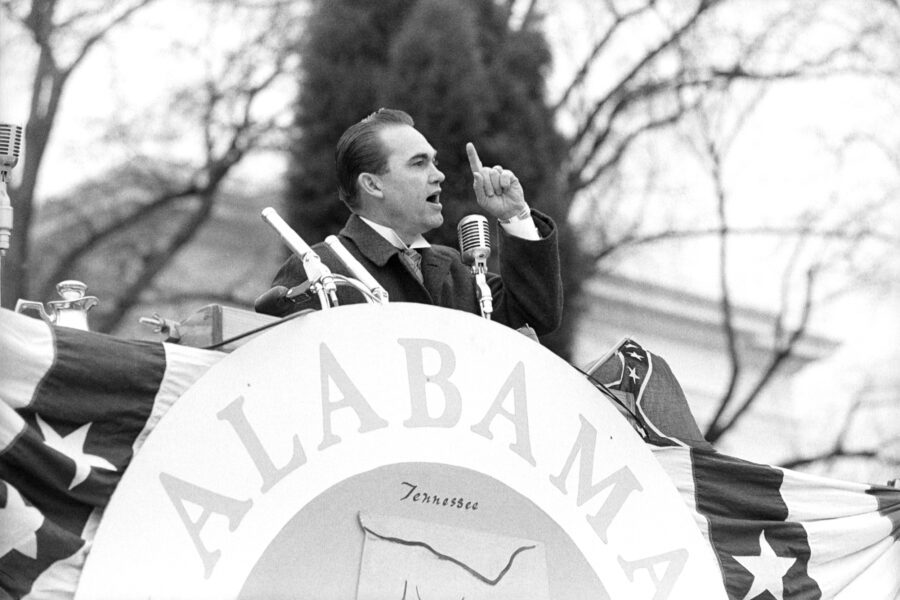From our collaborating partner “Living on Earth,” public radio’s environmental news magazine, an interview by host Steve Curwood with David Brancaccio of Marketplace Morning Report.
David Brancaccio, who you may know as the host of Marketplace Morning Report, is no stranger to climate disruption.
He lost his cottage in the Altadena community in the devastating Los Angeles fires this past January, only two months after moving in.
Back then, Living on Earth talked with Brancaccio as shock rippled through Altadena.
It’s now October, and while the fires may have disappeared from the headlines, many neighborhoods like Brancaccio’s are still trying to piece themselves back together.
Living on Earth checked in to see how he and Altadena are faring. This interview has been edited for length and clarity.
STEVE CURWOOD: So David, it’s been nine months since the fires, and eight months since we last talked to you. How’re you holding up? How’re you feeling?
DAVID BRANCACCIO: We’re doing OK. I worry about the neighbors. I really do. On my single block, just one street, by my count, 21 houses burned completely, and people were in different stages of their financial lives and just where they were in their lives when the fire happened, and so they’re able to move forward at different rates.
Some on the street are actually selling their property. They’re getting out. The decision that [wife] Mary Brancaccio and I have made is to, if it is at all possible, we’re really giving it the old college try: We have very firm plans to rebuild on that property, and so fits and starts, not quite sure if it’s all coming together, but we’re trying.
CURWOOD: Talk to me about the community there, this block where your house is. I mean, how are local businesses doing? Are people gathering? Are they communicating with each other? What’s going on?
BRANCACCIO: There are good things and bad things. The good things are, you get to know people. I was fairly new in that community, right? We met the neighbors really fast.
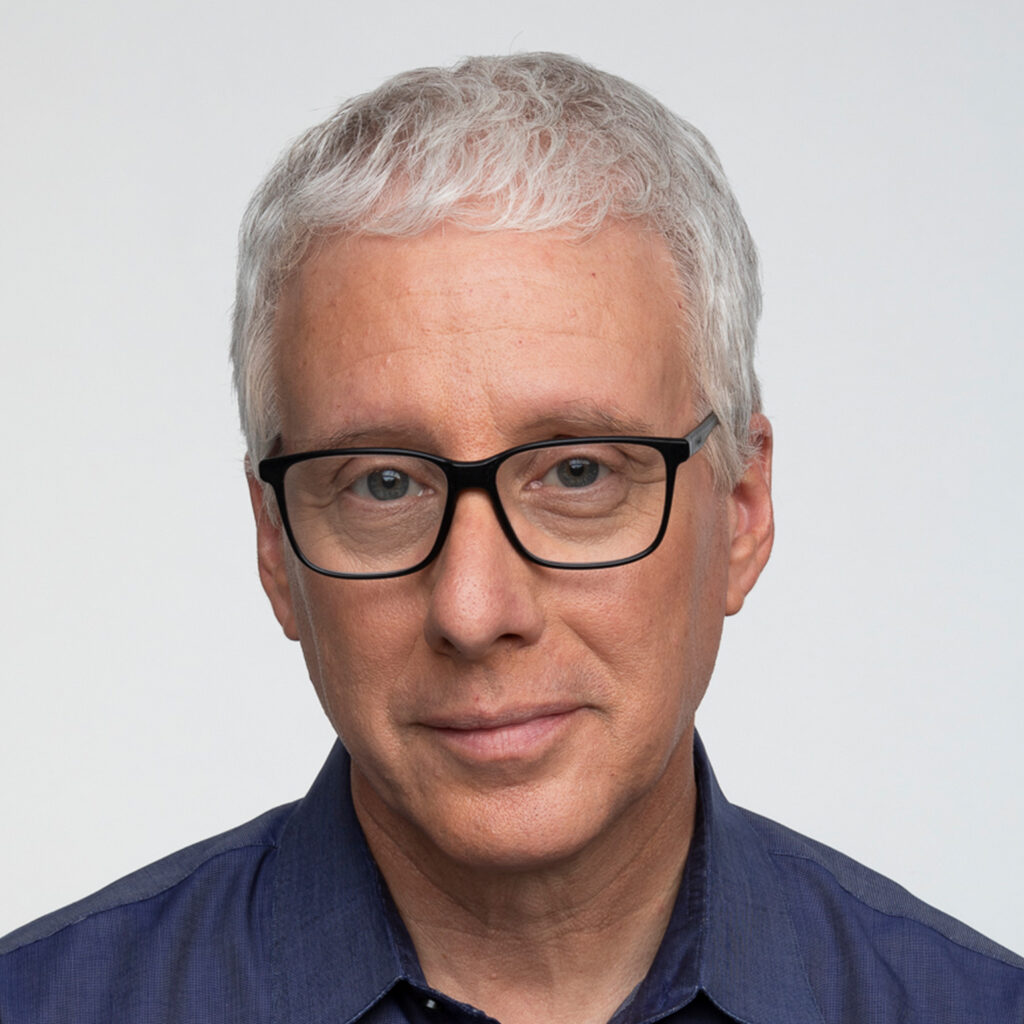
We have a wonderful WhatsApp group just for the block, run by a very committed neighbor named Ellen, and there’s a party in just a few weeks on a Sunday. Everyone who’s willing and able is going to show up. It’ll be a bit of a working party for me. I’m going to go with the tape recorder. I think that’s what I’m going to do on the one-year anniversary on my program is just, one year later, how are the people on one block faring?
The house that we lost was a cutesy English Tudor-y thing. There were almost 200 of those houses in the Altadena area, Janes cottages. That’s a group that has had some social gatherings and the exchange of information. There is something called the Altadena Collective, and it’s quite a formal organization where they’ve vetted some contractors.
They’ve had contractors come in and share what their prices would be and their approach, and then pro architects, who also lost houses in the group, evaluate those for us. We don’t have to use those contractors, but what if we could even rally together in the Altadena Collective and all buy our Class 1 fire resistant roof shingles as a group, right? We could probably save some money. So that’s the good part.
The bad part is, it’s really sobering. Steve, it really came home to me a few weeks ago.
USC [the University of Southern California], they did a program with high school students, nine from the Palisades fire, nine from the Altadena/Pasadena area. They brought in high school students this summer. I helped a little bit to do a reporting project. It was like oral history. And during the roundtable discussions, they were sort of, in a positive way, building on the conversation, looking at the positive side of this, that “this kind of adversity breeds character” kind of statements.
Then this one young man, I forget his first name, I’m sorry, from Altadena, said, “Look, it’s important to keep moving forward in a positive way. But can I just say,” he said, “this stinks. This is terrible.” He said he had just gone back to his family’s property for the first time after the fire earlier in the day, and all he wanted to do was pick up his phone and text his friends to come over, maybe give him some support, or just be there, maybe have some fun where they used to have fun. He said, “There’s no one who lives here who could come. Everyone is dispersed.”
So, you know, forget about the houses, forget about the trees. This guy has lost community.
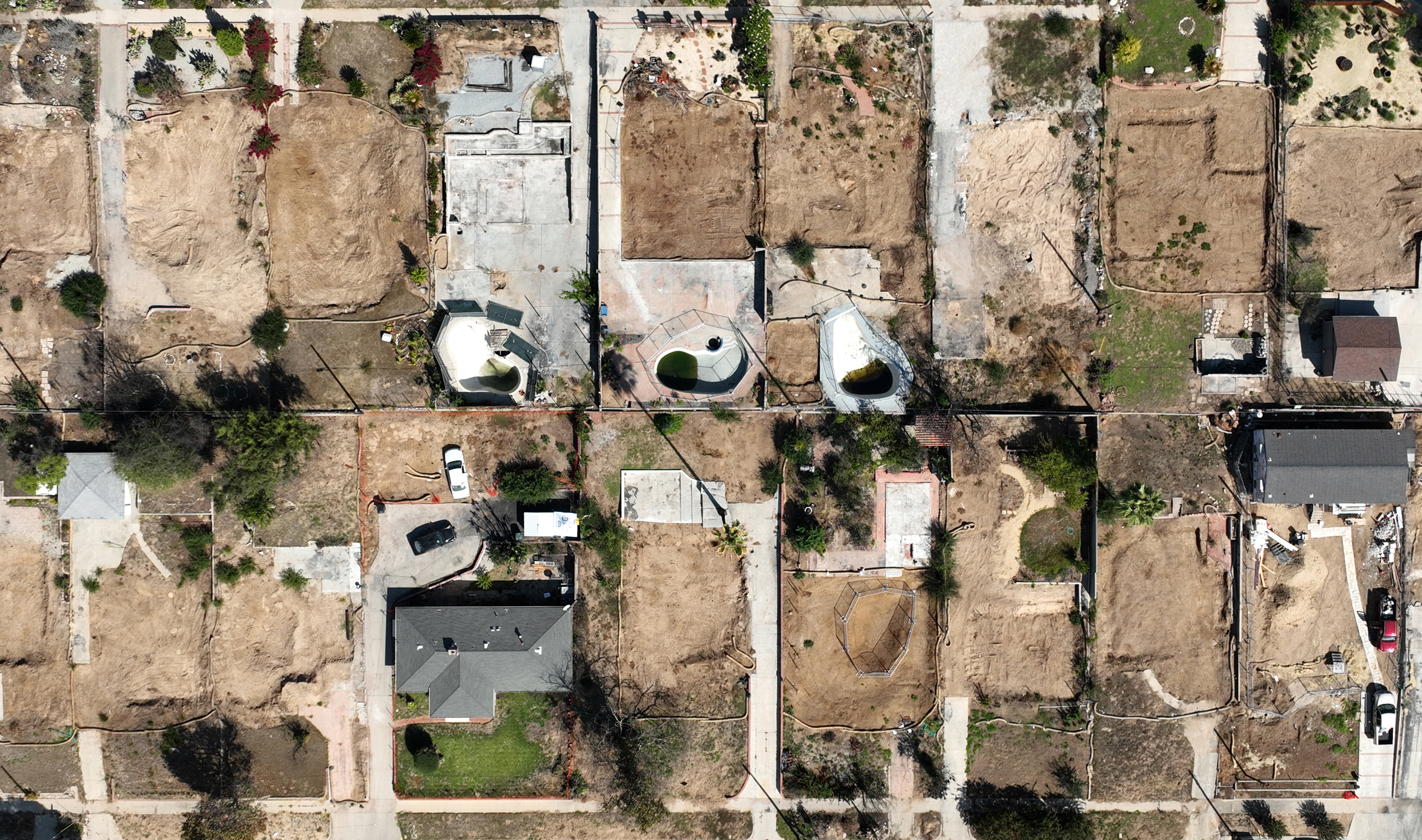
CURWOOD: What about the Brancaccios? You’re one of those, “Daggonit, we’re going to rebuild here.” I imagine you’ll do it a bit differently this time around. Talk to me about the designs that you have in mind.
BRANCACCIO: Yeah. So it was a 99-year-old house that burned. It was so perfect and precious in every way. It’s devastating to lose it, but we don’t want to rebuild it just like that. We have to think about fire hardiness. It is a new 100 years.
So we’re doing what we can, given the fact that I work for a nonprofit and I’m not independently wealthy, OK? It is said that the most sustainable way I could rebuild this house is what we’re trying if we can afford it. Big in Europe, big in the Pacific Northwest. It’s called cross-laminated timber.
You may have talked about mass timber on this program over the years. It looks like six-inch-thick butcher block. In a fire, they’re quite hardy. They’re better than steel, tests show. When you put 2000 degrees of flame on these things, they blacken with soot, and the soot becomes a barrier layer, and it doesn’t burn through. You’d have to fix it. You probably have to replace the panel, but hopefully it would keep the fire from entering the interior of the house.
The panels will face in, so there’s not much drywall to be imported from Mexico, probably with the tariff. We’ll see natural wood. It’s supposed to smell like wood, mineral wool insulation on the outside, and then concrete stucco over that, so it’ll look like a normal stucco California house on the outside, is the plan.
We’re hoping for a raised seam metal roof. We don’t have eaves that can catch embers. It’s still small; that’s one of our biggest nods to sustainability. And here’s the problem, it’s more expensive than studs and plywood, so you have to hope that you can find a building contractor here in Southern California who recognizes that they’ll use less labor putting it up. It’s supposed to take like three humans and a little crane thing. The thing that keeps us awake at night as we speak is the following: In about a week, two weeks, soon, four contractors will tell me how much they think it costs. We’re budgeted for ridiculous, but we’re not budgeted for off-the-charts stupid in terms of price.
We are paying, he said with resignation, a lot of money for the windows. We’re tempering everything, and it’s dual-pane everything—the old windows from 1926 were single pane—and that’s supposed to give you a decent shot at fire resistance.
The landscaping will be hardscape, mostly. We will have some desert succulents, but we’re not going to have stuff that catches fire near the house. It’s all electric, is the plan for the house. No gas service. So we’re trying.
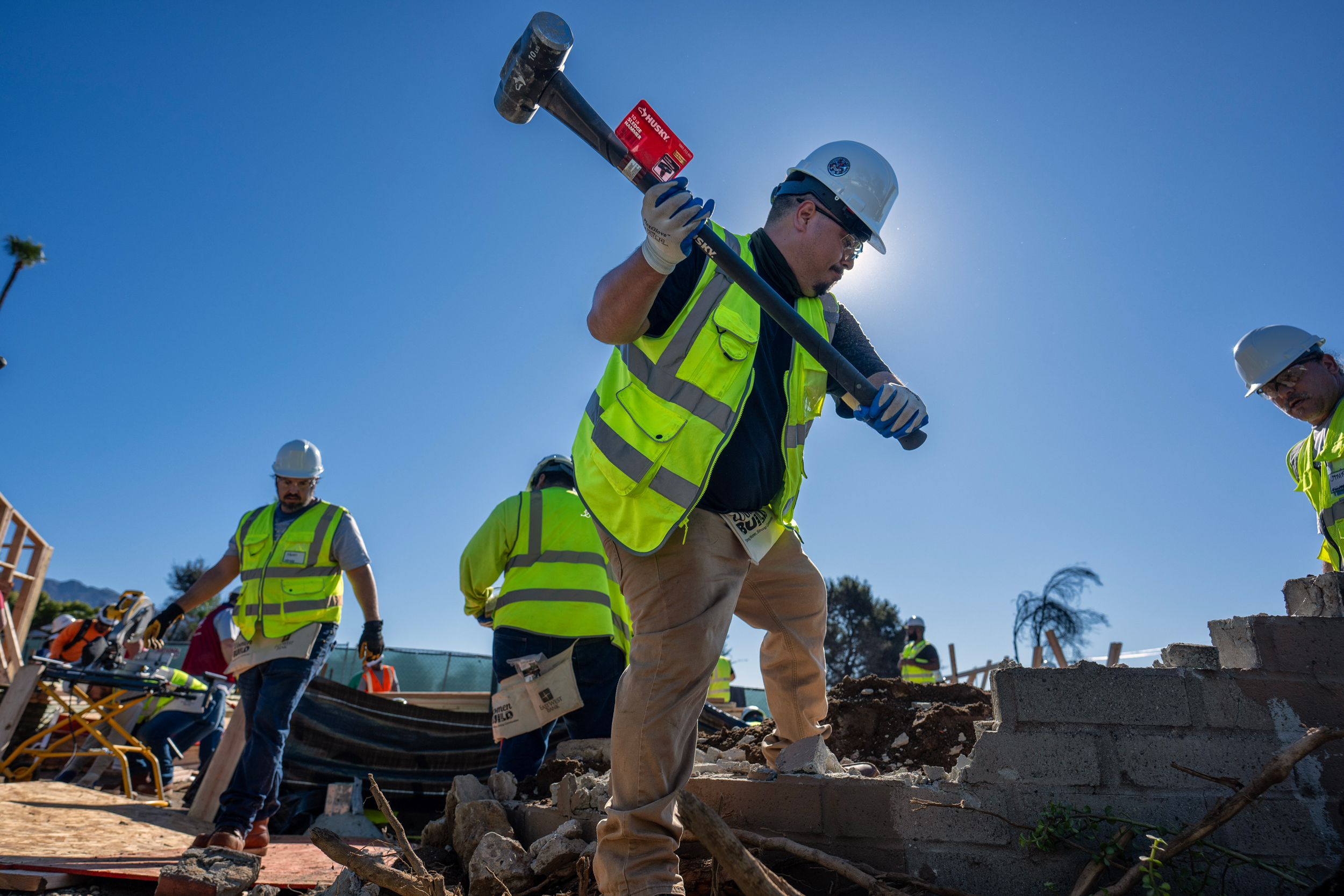
CURWOOD: Remember, those windows are going to really keep the hot, hot heat out and the heat that you want, or the cooling that you want, inside. So over the longer term, you’ll actually save money operating a building like that compared to the 100-year-old structure, which I imagine was fairly porous.
BRANCACCIO: Yeah, it’s fairly porous. I don’t think it’s going to be a net-zero house, but we’re going to get pretty close.
And in California, new constructions need to have solar panels. However, the governor waived that for the fire rebuilds to lift some of the burdens on people; you have to be solar-panel-ready. I mean, look, would I show my face on Living on Earth if I wasn’t going to put solar panels on this house? I’m putting solar panels on the house, and that could reduce my electricity bill to almost nothing.
So, you know, you do what you can. And I will admit this to you, Steve, there will be people listening to us feeling that I’m sounding sanctimonious about my green pedigree here. And they will say, David, if you really cared about the climate, move in with one of your kids in an existing structure.
CURWOOD: And you would say?
BRANCACCIO: And I would say, well, I’ve asked them, nobody’s raising their hands to welcome us into their midst. They also, you know, in the world of the affordability crisis, they don’t have big places. But the other thing is, Altadena is our only piece of real estate, OK? And the idea that this one real asset that I own wouldn’t be developed seems like poor personal finance.
I wish I was the guy who could buy property and turn it into a conservancy and plant wildflowers, and maybe I’ll win the lottery and do that someday. But we only got one plot of land that we own, and we’re putting a house on it at this point, if we can.
This story is funded by readers like you.
Our nonprofit newsroom provides award-winning climate coverage free of charge and advertising. We rely on donations from readers like you to keep going. Please donate now to support our work.
Donate NowCURWOOD: And what about the notion of optimism, courage in this time of, let’s face it, climate change is steadily getting worse. So what does it say for you and your family to make this statement in society that doggone it, we will persevere?
BRANCACCIO: Yeah, at a time that some people start conversations with me about moving out of the country because of the direction of politics, from their perspective, right? Here I am, wanting to cling to real estate in California.
I remember being a kid when we thought that nuclear war was going to break out at any minute. And I’m not saying the nuclear threat is in any way in retreat. It’s just not top-of-mind the way it was. But we somehow tried to envision a better future, tried to invest in our friends, our communities, our own educations, have kids that were productive members of society one way or another.
And that’s how we’re feeling now, which is, there was something special about Altadena. Everybody says it about the nature of community there. There are two bars in Altadena that did not burn. One of them is super cool; it’s run by a school teacher. But there’s this other bar, too, closer to where our property is, called Good Neighbor, and they built an external, like a patio thing that’s become a community venue. They bring in food trucks, they do music. They do events. The public station in Southern California, one of them is called LAist, they had me do a community event there with some experts on fire rebuilds. And it’s a real amenity that has been working very well.
There is a Thai restaurant on one of the commercial boulevards, where there’s still this devastation to the left and to the right, but they’re doing brisk business. There is a burger joint not far away that’s fantastic that’s doing brisk business, because I think people understand that once we rebuild our houses, we want these enterprises to be still standing so we can go back to them.
CURWOOD: What’s the next step for rebuilding there in Altadena?
BRANCACCIO: We got a bunch of milestones upon us. First of all, we’re going to find out how much contractors want to build it and see if we have the money. Ooh, then when are these permits going to show up? Let’s say the permits show up in a couple months. We can pour a foundation. Wooden panels are supposed to show up on a truck 12 weeks after I put down a down payment on them.
So am I speaking with misplaced optimism? Could we tip wooden panels up into position by Valentine’s Day? Earlier? We shall see. But once those panels are up, it’s only about another six months ’til we could move in. So I have high hopes that we’ll get permits. I have high hopes we’ll have the money for this, and I’ll be delighted to come back and report on if it ever happened, and if ours can be built for a reasonable amount.
If we can show that the economics of this work, I think it’s going to produce a delightful house, and maybe other people will adopt this more sustainable technique to construction.
About This Story
Perhaps you noticed: This story, like all the news we publish, is free to read. That’s because Inside Climate News is a 501c3 nonprofit organization. We do not charge a subscription fee, lock our news behind a paywall, or clutter our website with ads. We make our news on climate and the environment freely available to you and anyone who wants it.
That’s not all. We also share our news for free with scores of other media organizations around the country. Many of them can’t afford to do environmental journalism of their own. We’ve built bureaus from coast to coast to report local stories, collaborate with local newsrooms and co-publish articles so that this vital work is shared as widely as possible.
Two of us launched ICN in 2007. Six years later we earned a Pulitzer Prize for National Reporting, and now we run the oldest and largest dedicated climate newsroom in the nation. We tell the story in all its complexity. We hold polluters accountable. We expose environmental injustice. We debunk misinformation. We scrutinize solutions and inspire action.
Donations from readers like you fund every aspect of what we do. If you don’t already, will you support our ongoing work, our reporting on the biggest crisis facing our planet, and help us reach even more readers in more places?
Please take a moment to make a tax-deductible donation. Every one of them makes a difference.
Thank you,

